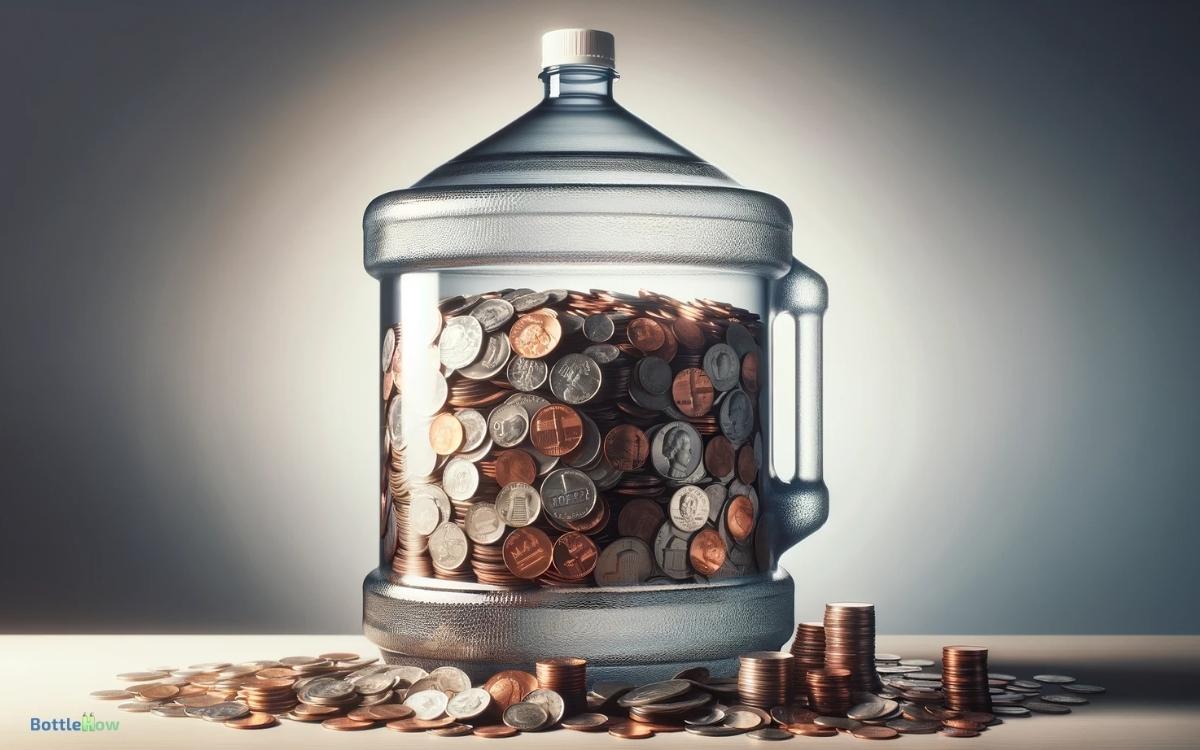How Much Change Can a 5 Gallon Water Jug Hold? Explained
A 5-gallon water jug can hold around 18.93 liters, equivalent to nearly 20,000 cubic cm. Depending on the mix of coins, you can estimate the jug’s capacity.
For example, a penny occupies 0.36 cubic cm, while a quarter takes up 1.75 cubic cm. Considering packing efficiency, if you use a mix of coins, the jug can hold roughly $700 to $1,200 worth of change.
However, exact value varies based on the proportions and arrangement of each coin type. To discover more about calculating the specific worth using different coin combinations, there’s more to explore.

Key Takeaways
Understanding Coin Dimensions
To determine how much change a 5-gallon water jug can hold, you first need to understand the dimensions of various coins. Nickels, dimes, quarters, and pennies all have different sizes and thicknesses, which affect how many can fit inside the jug. By calculating the total volume of the coins and comparing it to the capacity of the jug, you can estimate the possible amount of change it can hold. This could even help determine if the collected change is enough to cover the cost to refill 5 gallon of water. The arrangement of the coins also plays a role in maximizing the amount of change that can fit inside the jug. Stacking them neatly or allowing them to settle naturally can impact the total capacity. Understanding these factors is similar to learning how to fit a 5 gallon bottle into a compact space efficiently.
Each coin type, such as pennies, nickels, dimes, and quarters, has specific diameters and thicknesses.
For instance, a penny has a diameter of 19.05 mm and a thickness of 1.52 mm. Nickels measure 21.21 mm in diameter and are 1.95 mm thick.
Dimes are smaller, with a diameter of 17.91 mm and a thickness of 1.35 mm. Quarters measure 24.26 mm in diameter and 1.75 mm in thickness.
Calculating Volume and Capacity
Calculating the volume and capacity of a 5-gallon water jug involves understanding both the jug’s total volume and how much space each type of coin occupies.
A 5-gallon jug holds approximately 18.93 liters. To find out how many coins you can fit, you need to know each coin’s volume.
Once you’ve got these measurements, you can estimate the total number of coins the jug can hold.
Here’s a quick reference table for coin volumes:
| Coin Type | Volume (cubic centimeters) |
|---|---|
| Penny | 0.36 |
| Nickel | 0.69 |
| Dime | 0.33 |
Coin Types and Their Value
Understanding the value of each coin type is crucial for estimating the total monetary worth a 5-gallon water jug can hold.
U.S. coins include pennies, nickels, dimes, quarters, half dollars, and dollar coins, each with distinct values.
Pennies are worth 1 cent, nickels 5 cents, dimes 10 cents, quarters 25 cents, half dollars 50 cents, and dollar coins 100 cents.
Packing Efficiency and Space
Efficient packing efficiency directly impacts the total amount of change a 5-gallon water jug can hold. A higher packing efficiency allows more coins to fit in the available space, maximizing the total value that can be stored. Factors such as coin shape, arrangement, and distribution influence this efficiency, affecting the jug’s overall capacity. Additionally, considering how often to clean water jug surfaces ensures that accumulated dust or residue does not interfere with storage or retrieval of the coins.
You need to bear in mind how tightly you can pack different coin types. The space between coins can reduce the jug’s capacity significantly.
Let’s break down key factors:
| Factor | Impact on Capacity |
|---|---|
| Coin Shape | Round shapes leave gaps |
| Coin Size | Larger coins fit fewer |
| Coin Thickness | Thicker coins stack less |
| Arrangement | Random vs. organized |
| Material Density | Heavier coins settle more |
Estimating Total Worth
To estimate the total worth of the change in your 5-gallon water jug, you’ll need to take into account the average value of the different coin types and their distribution.
Start by categorizing the coins into pennies, nickels, dimes, and quarters. Count a representative sample from a smaller portion of the jug to find the average number of each coin type.
Multiply these averages by the total estimated number of coins in the jug. Use the following values: pennies = $0.01, nickels = $0.05, dimes = $0.10, and quarters = $0.25.
Add the results to get an estimated total worth. This method provides a practical approximation without counting every individual coin.
Conclusion
Just as a tiny acorn can grow into a towering oak, your 5-gallon water jug, filled with coins, symbolizes potential wealth.
By grasping coin dimensions and packing efficiency, you’ve tapped into the jug’s capacity and estimated its worth.
Like a well-organized library, each coin fits perfectly into place, maximizing space and value.
Through this analytical lens, you’ve transformed a simple container into a treasure trove, demonstrating that meticulous calculation can turn ordinary objects into extraordinary assets.






